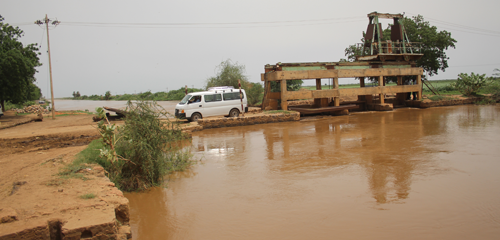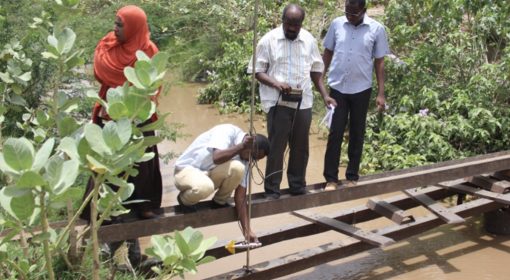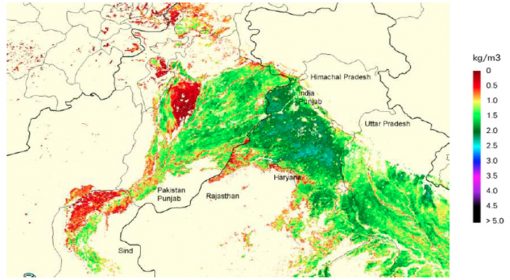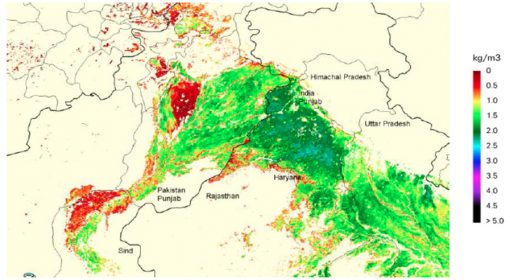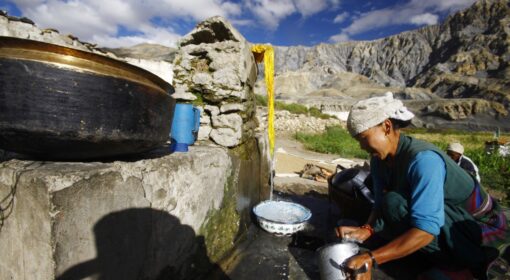by Abraham Mehari Haile, Eltigani Bashier and Frank van Steenbergen
2 September 2016
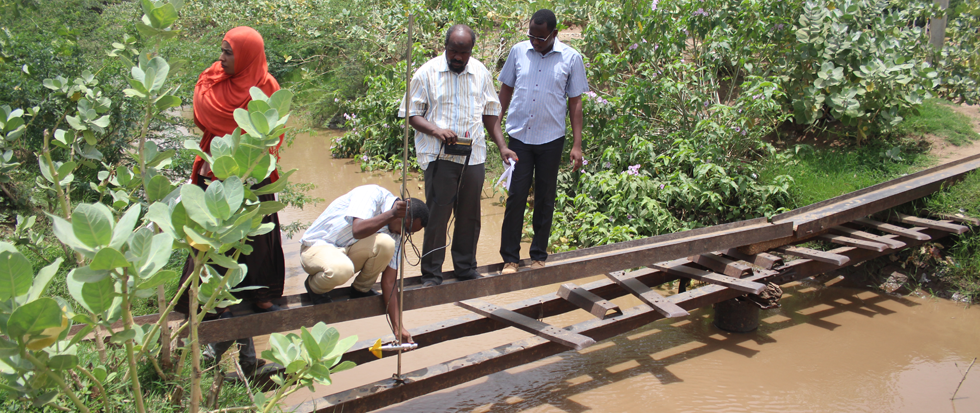
Measurements in major irrigation canal (credit: Bart Schultz)
They are the big elephants in the room – the mega-irrigation systems of the water world. Located along many of the world’s large rivers that traverse arid areas – be it the Indus, Ganges, the Nile, the Amur Daya they measure may 500,000 hectares or more, even up to 14 Million Ha, as in the Indus Food Machine Pakistan’s large integrated irrigation systems. Mega-irrigation systems are not only the world’s large water single water consumers but they are also faced with challenges that are of an entirely different order than other water systems.
First is their sheer size. Head and tail of the system may be hundreds of kilometres apart. It is all but easy to distribute water equally, fairly or even reasonably. The chances that water is stolen or plainly diverted along the way are large. Or even more mundane, simply damage may happen. Canals may be breached and weirs may malfunction – all amplifying into a ripple effect at the lower part of the systems. It is moreover not only that the tail of the system suffer from water shortage. When there is too much water in the mega system, excess also ends up downstream, causing flooding and water logging. Because of their size mega-irrigation often appear almost too big to handle. The image is that of blind men feeling around the elephant in the room and desperately trying to make sense of it.
Then they are more than irrigation systems. The mega-irrigation systems put a heavy footprint on the entire landscape – not only the canals and drains but also the roads, the bridges, the urban settlements, the residential property. These huge man-made irrigation systems determine what happens where – not just in agriculture but in all other aspects in life.
Thirdly, mega irrigation systems are part of politics. Their importance is so large is that there is no way that politicians and power brokers will ignore them. In fact local power struggles are very much shaped by the mega systems themselves. The relations between upstream and downstream users, the access to land and water, the breaching of structures during floods, the reallocation of canal inlets – all is breathing with politics. The power games appear in many shapes – in influencing appointments; in interfering with the water allocations or in mobilizing masses around sometimes trivial water management issues. Mega systems are so big that they are almost always politicized.
The result, however, of all these factors is that mega irrigation systems often heavily underperform. They have areas with severe scarcity and severe abundance of water – both equally problematic. Too little water means low yields, insecurity, and salinization. Too much water causes sogginess and saline land crusts – also depressing yields.
In fact though they are – the non beneficial ET in Sindh was estimated at 85% meaning that 5/6 of the water is not used by the plant. In several mega irrigation systems the oversupply of water is so much that yields increased during dry years! Another counterintuitive factor is that whilst in small irrigation systems there are clear rules and water rights, in mega systems this is often all together missing. Often the large systems are being run blindly, similar to the image of the men groping at the large elephant.
Because of the underperformance many mega irrigation systems have been made subject to institutional reforms – bringing in business management, creating Water Users Associations, removing and replacing staff and promoting the direct payment for volumetric water use. Sadly, many of those well-mentioned efforts have left the systems worse off than they were before – with the old routines gone but nothing effective to replace it. The Gezira system in Sudan (see box) is testimony to this, but many mega systems have gone through similar unsuccessful attempts to put the house in order.
| The Gezira: a history of changes Established in 1925 and supplied by one of the global engineering marvels, the Sennar Dam, the Gezira is the largest irrigation system in Sub Saharan Africa. Gezira scheme is the oldest (90 years) and the largest (approximately one million Hectare) in the region located in rich soil zone in central Sudan and consumed one third of the country share from the Nile water (18.5 milliard). As mega system the scheme experienced challenges in water management both in supply and uses. Four big changes in polices followed by change in objectives of the scheme resulted in cumulative effects. Irrigation system was changed from irrigation during the day time to continuous irrigation (day and night). The cotton crop was diversified with other crops and these other crops were intensified putting the system under pressure. Value of water rates and methods of collection influenced operation and maintenance. Also all engineering staff was withdrawn in one of the reforms, leaving the systems in the hands of agriculturalist instead. All attempts unfortunately resulted in low performance and low yield which discouraged farmers to attend irrigation and to contribute effectively in water management. As a mega irrigation scheme, Gezira needs to be turned to mega multipurpose scheme.
|
We argue rather than putting institutional reform foremost, it is better to also work on better water management in the mega systems. Much is possible – for instance by tailoring the supply of surface water to the reuse of groundwater: where land is sandy and there is no saline groundwater, the shallow groundwater can be used intensively – it will allow precision farming and will remove the need for drainage. This is the secret of ‘conjunctive management’ – providing just enough water – if less, there is scarcity and groundwater tables may fall; if too much there is water logging – but anything in that perfect middle will keep people pumping. As the groundwater (fed by seepage from canal water) is shallow, pumping it up is relatively cheap.
Another improvement is to manage the mega irrigation systems not just as agricultural system, but look at all their functions: drinking water supply, fishery, forestry, navigation, climate proofing, public health, stockwater, road and residences, etc etc. This will help to optimize the many functions of the mega systems. It will also generate revenue for the upkeep and create jobs. By managing mega irrigation systems better and introducing clear rights, rules and regulations and using the available water irrigation intensities and command areas can go up – fulfilling their large unfulfilled promise.

